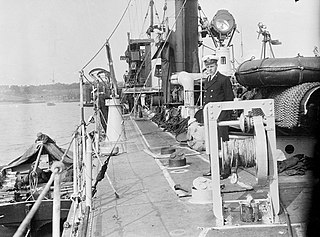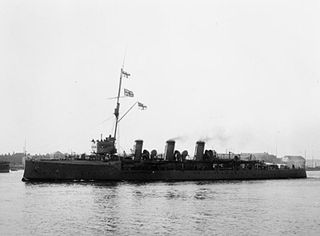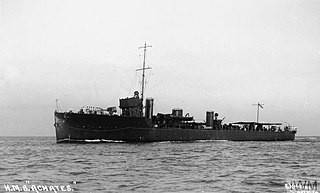
HMS Ambuscade was an Acasta-class destroyer of the Royal Navy and was launched in 1913. She served throughout the First World War, forming part of the Grand Fleet and taking part at the Battle of Jutland, serving in the Dover Patrol and spending the latter part of the war as a convoy escort. She was sold for scrapping in 1921.

The Boadicea-class cruiser was a pair of scout cruisers built for the Royal Navy in the first decade of the 20th century. They were the first class of this type to be fitted with steam turbine machinery. Upon completion in 1909–10, the sister ships served as flotilla leaders for destroyer flotillas of the First Fleet until 1913 when they were assigned to battleship squadrons. When the First World War began in August 1914, they remained with their squadrons as the First Fleet was incorporated into the Grand Fleet, although they changed squadrons over the course of the war. Both ships were present during the Battle of Jutland in mid-1916, but neither fired a shot. They were converted into minelayers the following year and both ships laid minefields in early 1918 in addition to other missions. The sisters were reduced to reserve in 1919 and sold for scrap in 1921 and 1926.

HMS Laforey was the lead ship of her class of destroyer built for the Royal Navy. Launched a year before the First World War began, she was attached to the Dover Patrol. Laforey saw action in several engagements with German torpedo boats, including the Battle off Noordhinder Bank and the action of 17 March 1917. Laforey was sunk in 1917 by a British mine after escorting several freighters to France. She was named for Francis Laforey, captain of HMS Spartiate at the Battle of Trafalgar in 1805.

The Active-class cruisers were a trio of scout cruisers built for the Royal Navy shortly before the First World War. They were initially assigned to the First Fleet and became destroyer flotilla leaders in 1914. Amphion and Fearless and their flotillas were assigned to the Harwich Force when the war began in August 1914. They went out on a patrol on the first day of the war and Amphion and her destroyers encountered and sank a German minelayer. On the voyage home, the cruiser struck a mine laid by the German ship and sank. She was the first ship of the Royal Navy to be sunk in the war.

HMS Active was the name ship of her class of three scout cruisers built for the Royal Navy in the 1910s. Completed in 1911, she was briefly assigned to several different units until the ship became the flotilla leader of the 2nd Destroyer Flotilla (DF) in 1914. When the First World War began in August of that year, the 2nd DF was assigned to the Grand Fleet where their primary task was to protect the fleet from submarines.

HMS Blanche was the second of two Blonde-class scout cruisers built for the Royal Navy in the first decade of the 20th century. She led the 1st Destroyer Flotilla from completion until 1912 and was then briefly transferred to the 4th Destroyer Flotilla before the ship was assigned to the 3rd Battle Squadron in 1913. During World War I, Blanche was assigned to several different battleship squadrons of the Grand Fleet. She was present at, but did not fight in, the Battle of Jutland in mid-1916. The ship was converted into a minelayer in early 1917 and made 16 sorties to lay mines during the war. Blanche was paid off in 1919 and sold for scrap in 1921.

The Blonde-class cruisers were a pair of scout cruisers built for the Royal Navy in the first decade of the 20th century. Upon completion in 1910–11, they served as flotilla leaders for destroyer flotillas of the First Fleet until 1913 when they were assigned to battleship squadrons. When the First World War began in August 1914, they remained with their squadrons as the First Fleet was incorporated into the Grand Fleet, although they changed squadrons over the course of the war. Blonde did not participate in the Battle of Jutland in mid-1916, unlike her sister ship, Blanche, which did, but never fired a shot. They were converted into minelayers the following year, but only Blanche actually laid mines. The sisters were reduced to reserve in 1919 and sold for scrap in 1920–1921.

HMS Bellona was one of two Boadicea-class scout cruisers built for the Royal Navy in the first decade of the 20th century. The ship served as the flotilla leader for the 2nd Destroyer Flotilla from her completion in 1910 until 1913 when she was transferred to the 1st Battle Squadron. Bellona spent the bulk of World War I with that squadron. She was present at, but did not fight in, the Battle of Jutland in mid-1916. The ship was converted into a minelayer in mid-1917 and made four sorties to lay her mines before the end of the war. Bellona was reduced to reserve in 1919 and sold to be broken up for scrap in 1921.

HMS Boadicea was the lead ship of her class of scout cruisers built for the Royal Navy in the first decade of the 20th century. She led the 1st Destroyer Flotilla from completion until the ship was transferred to the 3rd Destroyer Flotilla in mid-1912. A year later Boadicea was reassigned to the 2nd Battle Squadron and she spent the bulk of World War I with that squadron. The ship was present at, but did not fight in, the Battle of Jutland in mid-1916. Boadicea was converted into a minelayer at the end of 1917 and made three sorties to lay her mines before the end of the war. She was placed in reserve after the war and taken out of service in 1920. The ship was used for harbour service at Dartmouth until she was sold for scrap in 1926.

HMS Skirmisher was one of two Sentinel-class scout cruisers built for the Royal Navy during the first decade of the 20th century. Completed in 1905 the ship was placed in reserve until she was commissioned in 1907 as part of the Home Fleet. She then spent the next seven years moving on and off of active service in British waters. Skirmisher was assigned to coastal defence duties when the First World War began in 1914, although she was transferred to the Mediterranean in 1915 and then to the Aegean two years later. The ship returned home in mid-1919 and was sold for scrap in 1920.
HMS Owl was an Acasta-class destroyer of the Royal Navy, launched in 1913. The destroyer was part of the Grand Fleet during the First World War and took part in the Battle of Jutland. Owl survived the war and was sold for scrap in 1921.
HMS Starfish was an R-class destroyer which served with the Royal Navy. She was launched on 27 September 1916 and sold to be broken up on 21 April 1928. She was built by Hawthorn Leslie of Hebburn Tyne.
HMS Laverock was a Laforey-class destroyer of the Royal Navy. She was launched in 1913 and entered service in October 1914. Laverock served through the First World War, operating with the Harwich Force and in the English Channel. She was sold for scrap in 1921.
HMS Lightfoot was a Marksman-class flotilla leader of the British Royal Navy. Construction by J. Samuel White began in June 1914, shortly before the outbreak of the First World War, and the ship was launched and completed in 1915. She survived the war and was sold for scrap in 1921.

HMS Rob Roy was a Royal Navy R-class destroyer constructed and then operational in the First World War. The ship served in the Grand Fleet as part of the Fifteenth Destroyer Flotilla.
HMS Christopher was an Acasta-class destroyer of the British Royal Navy. She was built by Hawthorn Leslie in 1911–1912. She served throughout the First World War, forming part of the Grand Fleet until 1916 and taking part in the Battle of Jutland. Later in the war she served in the English Channel to protect merchant shipping against attacks by German U-boats. Christopher was sold for scrap in May 1921.
HMS Lark was a Laforey-class destroyer of the British Royal Navy. The Laforey class was the class of destroyers ordered under the Royal Navy's 1912–1913 construction programme, which were armed with three 4-inch (102 mm) guns and four torpedo tubes and were capable of 29 knots. The ship, which was originally to be named Haughty but was renamed before launch, was built by the Scottish shipbuilder Yarrow between 1912 and 1913.

HMS Achates was an Acasta -class destroyer of the British Royal Navy. She was built by the Scottish shipbuilder John Brown and was built between 1912 and 1913. Like all Acasta-class destroyers, Achates was armed with three 4-inch (102 mm) guns and two torpedo tubes, with a specified speed of 29 knots.

HMS Alarm was a Acorn-class destroyer of the British Royal Navy. She was built by John Brown and Company at their Clydebank shipyard, being built between 1910 and 1911, completing in March 1911. Alarm had oil-fuelled steam turbine machinery that was designed to give a speed of 27 knots. Armament consisted of two 4-inch guns, two 12-pounder guns and two 21-inch torpedo tubes.

HMS Lawford was a Laforey-class destroyer of the British Royal Navy. The Laforey class was the class of destroyers ordered under the Royal Navy's 1912–1913 construction programme, which were armed with three 4-inch (102 mm) guns and four torpedo tubes and were capable of 29 knots. The ship, which was originally to be named Ivanhoe but was renamed before launch, was built by the Scottish shipbuilder Fairfields between 1912 and 1914.












